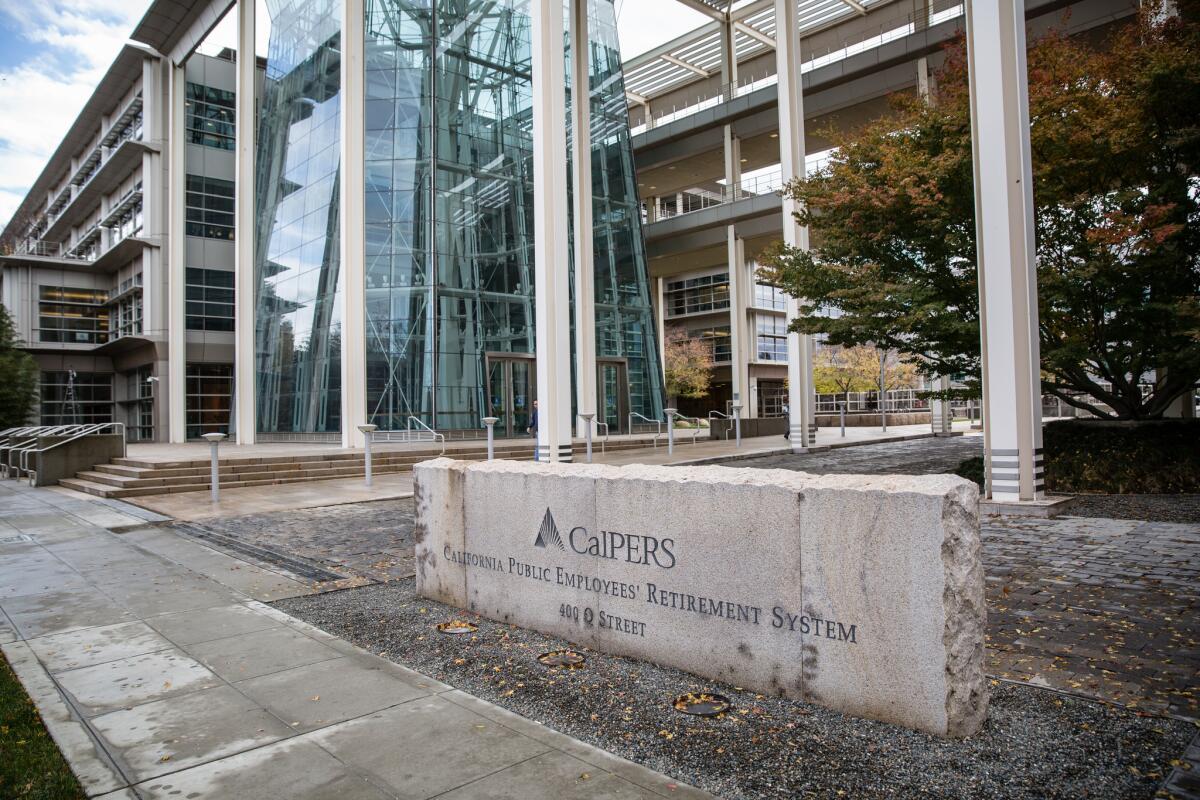CalPERS returns likely to fall short of 7.5% target, official says

The California Public Employees’ Retirement System building in Sacramento. The pension giant’s investment chief said its main fund will likely miss its 7.5% investment target.
The nation’s biggest public pension fund is falling far short of its annual investment goals.
The California Public Employees’ Retirement System earned only 3% in the 10 months ending April and will likely fall short of its 7.5% annual target when the fiscal year ends this month, the pension giant’s investment chief said.
Absent a “remarkable rally in the global stock market,” said Ted Eliopoulos, CalPERS’ chief investment officer, the ground to make up in two months is too great to avoid a likely shortfall.
“We don’t like to get too excited about any one-year return,” Eliopoulos said. “As the board is well aware, we would like to look at longer time periods as they are much more meaningful in measuring our performance.”
Eliopoulos’ remarks came in a prepared statement to the CalPERS board last week. A video of the meeting was posted on YouTube but not yet on CalPERS’ website. CalPERS posted monthly financial data Thursday.
Eliopoulos noted that the fund returned 18.4% in the fiscal year ended last June 30. He said the fund’s total value stood at $304.9 billion at the end of April.
The performance of CalPERS is closely watched in the financial world and has broad implications for California taxpayers.
Charged with paying benefits to 1.7 million current and future retirees, CalPERS has the power to compel government employers to make up any shortfall in its fund. The fund was only 77% funded at the end of last June, shy of the 80% funding generally considered adequate.
The 10-month financial statement posted Thursday showed that the fund’s global stock portfolio, which represents about 54% of the fund, returned 3.1% in the period, slightly below a benchmark that grew 3.4%.
The other big piece, bonds, which make up nearly 19% of the portfolio, turned in a strong performance in a volatile year, returning 4.3%, nearly nine-tenths of a percentage point better than the benchmark.
The big underperforming category this year has been real assets, which account for 10% of the fund, according to the statement. The category, dominated by commercial real estate, gained 3.7%, which was 4.7 points below its benchmark.
Real estate returned 3.3% in the period, a time when property values generally were making strong gains, and missed the benchmark by more than 4.75 percentage points. Forest land, which CalPERS is selling, returned 3.1%, missing the benchmark by more than 5 percentage points.
Commercial real estate was devastated by the financial crisis of 2008 and, though it has rebounded some, continues to dog the portfolio.
Real estate, like private equity, is often used by portfolio managers to provide diversification to mitigate losses during downturns and add to gains during low-return periods in public markets.
In his remarks, Eliopoulos noted that the fund’s average annual return has been 10.8% over three years, 9.5% over five years, 6.7% over 10 years and 8% over 20 years.
Michael Rosen, a principal at Angeles Investment Advisors, which advises institutional investors, said the year-to-date performance was “not outside the bounds of what might be reasonable.”
“Whatever your target, you’ll never going to hit it exactly in any given year,” he said.
Twitter: @deanstarkman
More to Read
Inside the business of entertainment
The Wide Shot brings you news, analysis and insights on everything from streaming wars to production — and what it all means for the future.
You may occasionally receive promotional content from the Los Angeles Times.











